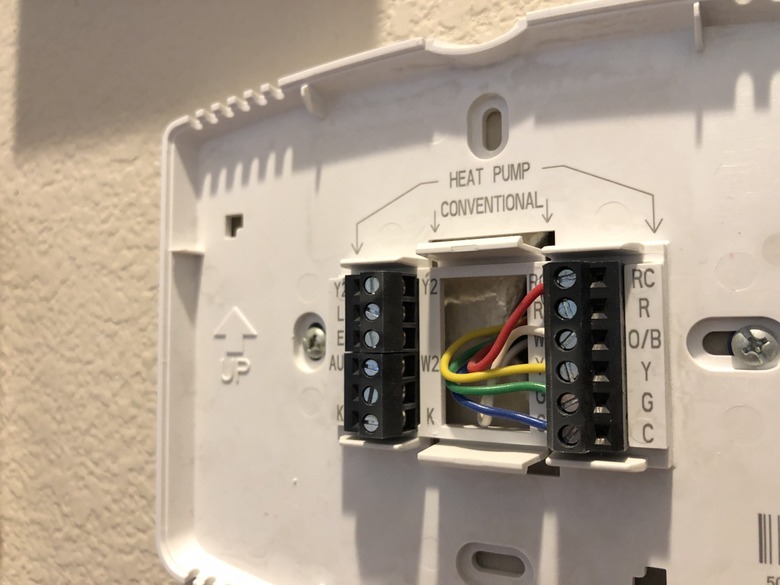How To Move A Thermostat
We may receive a commission on purchases made from links.
During a home renovation or when simply rearranging furniture and cabinets, you might find yourself wanting to move a thermostat. Thermostats are centrally located in a home or a zone of a system to control the comfort of the space being heated or cooled. Relocating it may cause issues in the comfort of your home, so finding the right location is always an important consideration.
Another consideration is the wiring that is involved in moving a thermostat, including how to route the new wire and how many wires it uses. All of this requires a certain amount of investigation. However, wireless thermostat alternatives help with both wiring and moving the thermostat. This DIY project requires some advanced wiring skills and knowledge of good thermostat placement. You may need to call a professional when you're considering moving a thermostat.
Moving a Thermostat
Moving a Thermostat
Thermostats are directly wired to a furnace or HVAC system, typically using 18-gauge thermostat wire. Depending on the complexity of your system, there can be anywhere from two to eight wires. The wires are typically bound together inside an insulated jacket, which simplifies installation. However, the wiring typically runs inside the wall and floor cavities, making it challenging to route new wiring if the walls are finished. During a home renovation that involves opening up the walls, which can be a fairly simple task; otherwise, you have to fish the wires through the finished walls.
Fishing Wire Inside a Wall
Fishing Wire Inside a Wall
Just as fishing in a pond requires a good amount of skill to find the bigger fish, so does fishing wires inside walls. A professional will use a special drill bit and a wire snake to make the job easier, but there are a few hacks that can work pretty well too, such as running the wire completely through a wall and into a closet or other inconspicuous location and then routing the wire through the floor or ceiling to the HVAC system.
Another hack is probing around inside the wall with a wire coat hanger and a flashlight after fishing it inside the wall cavity, which is not as easy as it sounds. This will all depend on the location of your system and your specific situation. Some systems are in the attic or garage, and some might be in the basement. Each will require some fishing techniques to bring home the catch.
How to Move a Thermostat
How to Move a Thermostat
The first step to moving a thermostat is to examine the current wiring:
- Start by shutting down the HVAC by turning off its power at the appropriate circuit breaker(s).
- Remove the thermostat cover to expose the wiring connections on the thermostat base.
- Take a photo of the thermostat base so you can see the color of each wire and the terminal it connects to on the thermostat. You will use this to ensure proper connection after relocating the thermostat.
- Move to the HVAC equipment and locate the thermostat wire. Trace the wire toward the thermostat as best as you can. This will help you plan the new wiring route.
- Identify where the new thermostat will go and determine whether or not you can reach the new location by moving the existing wiring. If not, you can run new wiring all the way from the HVAC equipment to the new thermostat. Alternatively, you can switch to a wireless thermostat and not have to bother with wire installation at all.
Tip
Be sure to use the same type and size of thermostat wire — including the same number of wires required — when replacing the old thermostat wire. The wires connected to the thermostat are called conductors. This information is necessary to make sure that there will be enough new conductors to control your HVAC system. You can never have too many conductors, but you can always have too few.
Wireless Thermostat for Your Furnace
Wireless Thermostat for Your Furnace
Like any technology, wireless thermostat technology has progressed immensely. There are various thermostat brands on the market that offer some sort of wireless thermostat for furnaces and all other HVAC needs. A wireless thermostat kit consists of an equipment interface module, a return air sensor, and the wireless thermostat itself.
The equipment module is wired directly to the furnace or HVAC system either at it or nearby, which minimizes how much wire you will need to successfully move a thermostat. This equipment module is the brains and communication from the wireless thermostat to the equipment being controlled.
The return air sensor monitors the air returning to the furnace or HVAC system and can take over in the event of communication loss from the wireless thermostat. This will maintain 62 degrees of heating and 82 degrees of cooling if this situation occurs. Other indoor air quality types of sensors and internet gateways can be added to the equipment interface module, either wired or wirelessly. As with any technology, you will need to program the wireless system for your specific needs.
The decision to move a thermostat is not one that should be taken lightly. With technology, however, it can be done either by a professional or an advanced DIYer.
